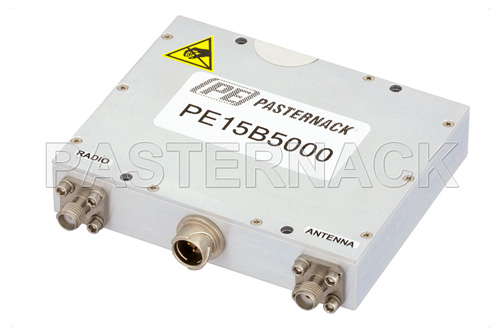 Bi-directional amplifiers are used to strengthen communication signals between two points for a wide array of applications. This include boosting signals along large subterranean or in-building distributed antenna systems (DAS), acting as a repeater to a remote observation station, and even enabling rapidly deployable portable networks with unmanned aerial vehicles (UAVs). As many modern uses for bi-directional amplifiers involve signals that are heavily modulated at extremely high data rates, the requirements of the transmission (TX) and reception (RX) are growing more stringent. The following blog will help describe some of the system level constraints and considerations when leveraging bi-directional amplifiers.
Bi-directional amplifiers are used to strengthen communication signals between two points for a wide array of applications. This include boosting signals along large subterranean or in-building distributed antenna systems (DAS), acting as a repeater to a remote observation station, and even enabling rapidly deployable portable networks with unmanned aerial vehicles (UAVs). As many modern uses for bi-directional amplifiers involve signals that are heavily modulated at extremely high data rates, the requirements of the transmission (TX) and reception (RX) are growing more stringent. The following blog will help describe some of the system level constraints and considerations when leveraging bi-directional amplifiers.
All of the Power Amplifier and Low Noise Amplifier Considerations
Bi-directional amplifiers are typically receiver and transmitters cleverly designed in a compact and efficient package. This means that the transmission circuitry has the same constraints of a standard transmitter and the reception circuitry has the same restraints as a standard receiver. However, these devices are contained in the same housing and sometimes must operate on the same ports. Moreover, any degradation experienced by a signal will only be worsened by amplification and retransmission. Hence, budgeting for these losses and acquiring a quality bi-directional amplifier can make all the difference in the integrity of the signal stream.
For example, the gain flatness of the transmitter and receiver in a bi-directional amplifier is critical, as the variations with gain over frequency will compound with that of the original transmitter and downstream receiver. This could cause errors in modulation methods that use an amplitude modulated component, such as QAM. The same is also true for the noise figure, and return loss, amongst other performance parameters. Also, with IEEE 802.11a/g/n (WiFi) radios, fast switching speed and high linearity are also key considerations as WiFi signals are sensitive to signal distortion.
Power
Typical transmitter and receiver systems are specified in their power usage for the specific modulation method they were designed for. Bi-directional amplifiers often have to cover several different modulation methods over a wide range of frequency. As the power requirements are different for various modulations, it is important to ensure that a bi-directional amplifier can provide the necessary power for a specific modulation scheme. Generally, high power levels will be available for frequency/phase modulated signals compared to amplitude modulated signals. Also, a bi-directional amplifier is running both transmit and receive functions in the same module, and required adequate power to operate both functions.
Interference
As bi-directional amplifiers are not co-located with the transmitter and receiver technologies, they are not prone to co-site interference. However, any interference introduced at the bi-directional amplifier site could lead to signal distortion and even packet errors. Even if a bi-directional amplifier is used to boost a signal along a transmission line, a nearby transmitter could cause signal leakage into the bi-directional amplifier. A bi-directional amplifier with quality housing, connectors, and well shielded coaxial cables can help to prevent external signal intrusion and interference.
Environmental Concerns
Bi-directional amplifiers are often located in areas that can connect two other critical locations, and are now even deployed in UAVs and land mobile vehicles. This sometimes leaves a bi-directional amplifier exposed to the elements, or having to undergo the rigors of mobility. Therefore, the weatherproofing, operating temperature range, and even altitude specifications of a bi-directional amplifier can’t be disregarded, like in less demanding applications.




 Pasternack Blog
Pasternack Blog
